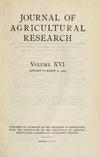SPATIAL VARIABILITY OF SOME SOIL PROPERTIES IN SAHL AL-HUSSAINIYAH, SHARKIA GOVERNORATE, EGYPT
引用次数: 3
Abstract
Sustainable soil management with appropriate understanding of soil characteristics is vital in maintaining and improving soil fertility. The objectives of the present study is to characterize the spatial variability across a soil for selected using GIS technique. A total of 120 geo-referenced representative soil samples (from 0 to 0.60 m depth) were collected from Sahl Al-Hussainiyah, Sharkia Governorate, Egypt. Analyses included pH, ECe, CaCO3, soil organic matter (OM), available N, P and K, cations exchange capacity (CEC) and bulk density (BD). Spatial distribution pattern varies from moderate to strong. The best fit semivariogram model of ECe, K and BD was stable model, whereas K-Bessel model was the best fit model of pH, OM and CEC. With the exponential model, the best fit was with CaCO3, N and P. According to the spatial distribution map, five zones were identified, where the study area was classified to < 7.17, 7.17 to 7.41; 7.41 to 7.66; 7.66 to 7.89, and > 7.8 for pH, < 6.70, 6.71 to 8.17; 8.18 to 9.73; 9.74 to 11.4, and > 11.5 dSm -1 for EC, < 2.3, 2.31 to 2.92; 2.93 to 3.76; 3.77 to 4.52, and > 4.53% for CaCO3, < 0.43, 0.44 to 0.52; 0.53 to 0.61; 0.62 to 69, and > 0.70% for OM, < 30.3, 30.3 to 37.9, 37.9 to 45.6, 45.6 to 52.6, and > 62.6 mg kg -1 for N, < 1.61, 1.62 to 2.43; 2.44 to 3.31; 3.32 to 4.30, and > 3.41 mg kg -1 for P. < 103, 104 to 113; 114 to 124; 125 to 132, and > 132 mg kg -1 for K, < 43.2, 43.2 to 46.8; 46.8 to 50.8; 50.8 to 55.8, and > 55.8 cmolc kg -1 for CEC and < 1.27, 1.28 to 1.32; 1.33 to 1.39; 1.40 to 1.51, and > 1.52 Mg m -3 for BD. Thus, this methodology can be used succsseffly in Spatial Variability of some soil properties.埃及沙尔基亚省萨赫胡塞尼亚部分土壤性质的空间变异
适当了解土壤特性的可持续土壤管理对保持和提高土壤肥力至关重要。本研究的目的是利用地理信息系统技术表征土壤的空间变异性。从埃及Sharkia省Sahl Al-Hussainiyah共收集了120个地理参考代表性土壤样本(深度从0到0.60 m)。分析包括pH、ECe、CaCO3、土壤有机质(OM)、速效N、P、K、阳离子交换容量(CEC)和容重(BD)。空间分布格局由中等到强烈。ECe、K和BD的拟合模型为稳定模型,pH、OM和CEC的拟合模型为K- bessel模型。指数模型与CaCO3、N、p的拟合效果最佳。根据空间分布图,划分出5个区域,分别为< 7.17、7.17 ~ 7.41;7.41 - 7.66;pH值为7.66 ~ 7.89,>为7.8,< 6.70,6.71 ~ 8.17;8.18 - 9.73;dSm -1 EC < 2.3, 2.31至2.92;2.93 ~ 3.76;CaCO3为3.77 ~ 4.52,>为4.53%,< 0.43,0.44 ~ 0.52;0.53 ~ 0.61;0.62 ~ 69, OM为0.70%,< 30.3,30.3 ~ 37.9,37.9 ~ 45.6,45.6 ~ 52.6,N为62.6 mg kg -1, < 1.61, 1.62 ~ 2.43;2.44 - 3.31;p < 103,104 ~ 113时为3.32 ~ 4.30,>为3.41 mg kg -1;114至124;K < 43.2, 43.2 ~ 46.8, 125 ~ 132, >为132 mg kg -1;46.8 - 50.8;50.8至55.8,>为55.8 cmolc kg -1, CEC < 1.27, 1.28至1.32;1.33 ~ 1.39;为1.40 ~ 1.51,>为1.52 Mg m -3。因此,该方法可以成功地用于某些土壤性质的空间变异性。
本文章由计算机程序翻译,如有差异,请以英文原文为准。
求助全文
约1分钟内获得全文
求助全文

 求助内容:
求助内容: 应助结果提醒方式:
应助结果提醒方式:


